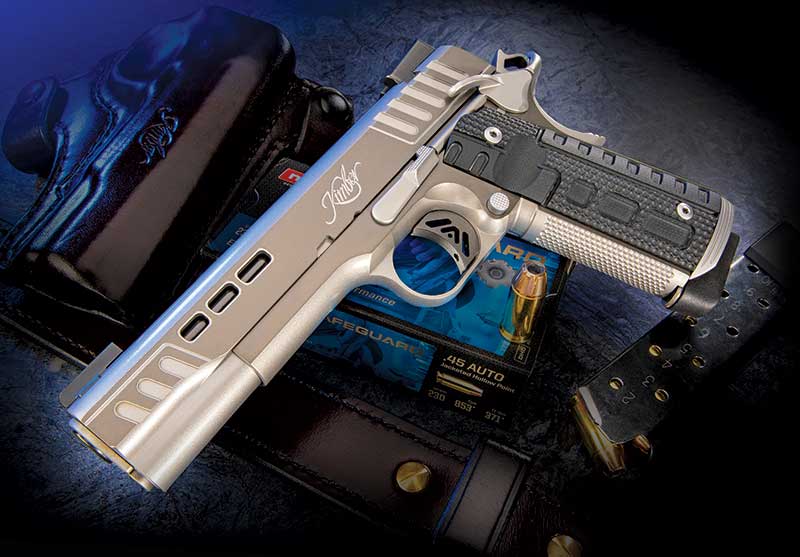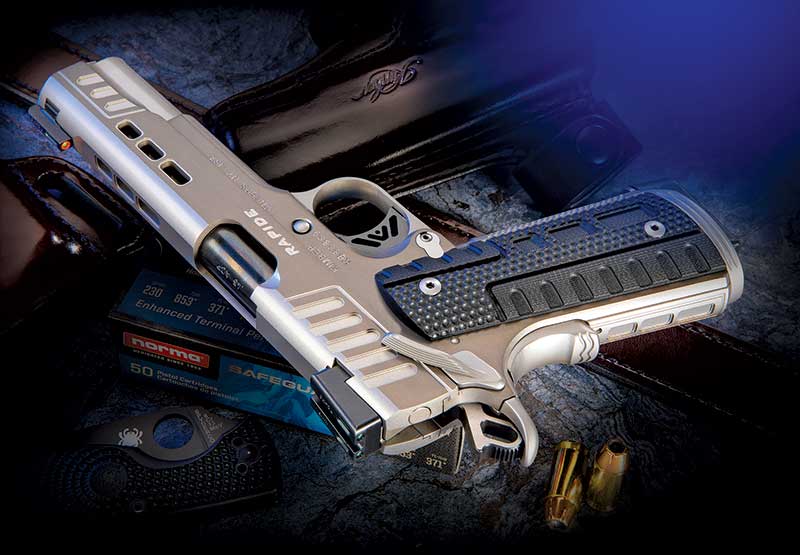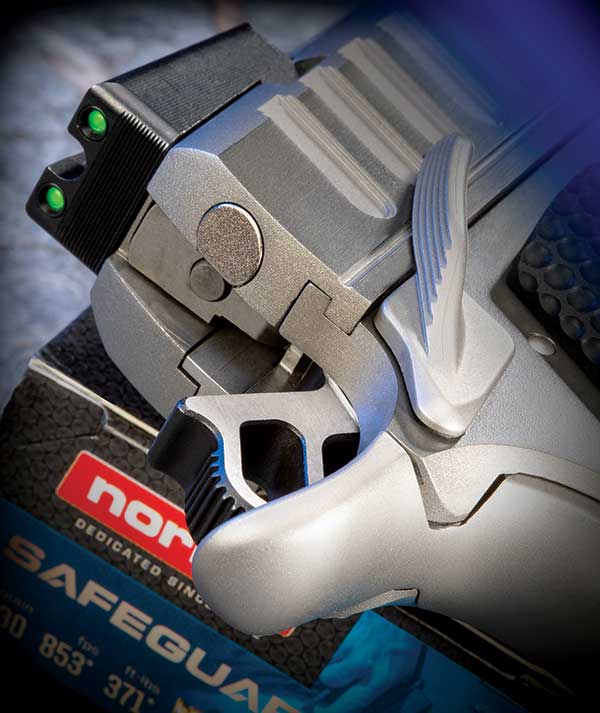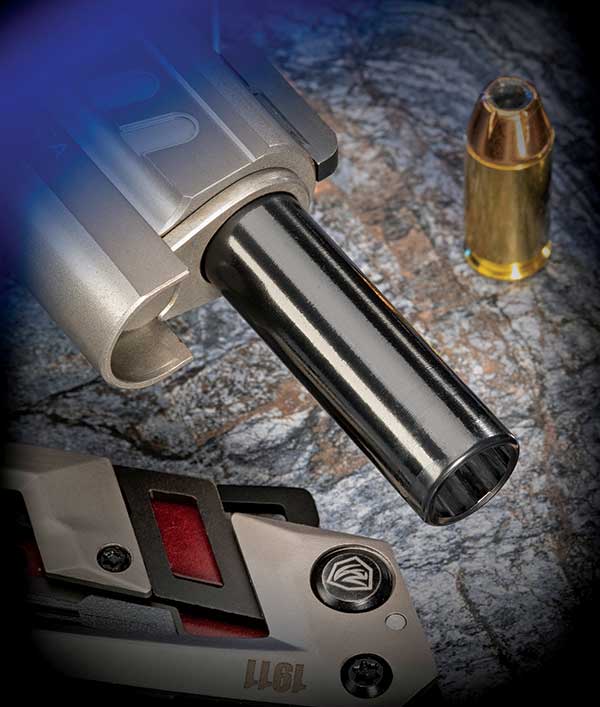Kimber's Rapide Black Ice 1911
Hang On Tight To This 10mm Express Train
Rapide seems to me a decidedly French word, conjuring images of croissants and retreat. But don’t hold this against the new Kimber Rapide Black Ice 1911 family of pistols. These futuristic gems are designed to perform with attitude — and they do. You might guess the word “Rapide” carries a speed connotation. As an adjective, it means fast or quick. As a noun, it often refers to a European express train. Aston Martin launched a high-end sports car back in 2010 called the Rapide. Its 5.9-liter V12 engine moved the sexy beast tres rapide, up to a maximum speed of 188 mph. Not bad for a sports sedan.
The Kimber Rapide, introduced last year, also draws its speedy name in part from design elements like slide-lightening cuts to reduce lock time and partly from its intended goal of being a serious competition-ready pistol right out of the box. It’s not cheap, but then again, the thinking is no “tweaking” is required to get this one in the winner’s circle.
The Black Ice part of the name refers to the second generation of Rapide pistols with an eye-catching two-tone Kimpro finish. While cosmetics are always a matter of personal preference, I have to say I love the aesthetics here. Calling objects like guns sexy drives my adult daughter crazy, but if any gun can be considered sexy, it’s this one. Think part brushed stainless coloring, with a darker hue, combined with a glass-like surface feel and appearance. Add black G-10 grips, a darker gray trigger finish, a shiny black DLC coated barrel, and this pistol is a looker. It’s got an ultra-modern vibe to it for sure. More on this in a minute.
The Rapide Black Ice has become a small nuclear family, with three caliber variations: 9mm, .45 ACP and the 10mm model we’re focusing on here. We’ve got some thoughts on the .45 ACP version too because Kimber kindly sent photographer Rob this version for some of the photos you see here.
Popsicle Sticks?
While trying to figure out how to describe the striking cuts, cocking serrations and grip texture, I had an inspiration. Popsicle sticks. Yeah, I know this is a gun magazine, but humor me for a hot second.
While the slide lightening cutouts are recessed and stepped rectangles, the cocking serrations are more like popsicle sticks cut in half — one end squared off and the other rounded in a perfect semicircle. Like the slide cutouts, these are also stepped. The rear cocking serrations have the rounded ends facing down while in the front they face up. The result of all this recessed and ledge cutting is a texture offering a sure grip while not gouging your sides when carrying inside the waistband. And the Rapide has become a carry pistol in my world.
You’ll also see an encore performance of the same pattern on the black grip panels — those same cutouts enter both front and rear of each panel and combine with interior rectangular cutouts and a dimpling pattern. The result is a nifty-looking design providing plenty of useful texture.
Frame and slide are both heavily melted in key spots for carry friendliness. The slide features a flat section on top that transitions via a wide-radiused curve to the “slab” sides. There are few hard edges present on this pistol. The base of the slide has a hard angle but given its location, it doesn’t interfere with hands or holster. You’ll also find radiused cutouts entering the trigger guard on both sides with no favoritism shown to right- or left-handed shooters. While we’re talking about the smoothing cuts, you’ll notice most of the cut and recessed areas are finished with a lighter shade of the Kimpro Black Ice finish, creating the striking two-tone effect.
Mechanicals
The Rapide Black Ice is all 1911. It doesn’t have a full-length guide rod, so some large percentage of you can cheer while another large percentage can wallow in misery. I’ve got both styles and quite frankly, I don’t care one way or the other. If it runs reliably and shoots small groups, I’m happy. I haven’t yet needed to do a high-speed tactical field stripping, so a requirement, or not, for a disassembly tool isn’t a big deal for me.
I should note both frame and slide are stainless steel, which explains the 40.7-oz. weight. That’s according to our digital kitchen scale. Don’t tell my wife. In this pistol, the heavier steel frame is a good thing given its 10mm chambering.
The trigger is outstanding, especially for carry or defensive applications. The cuts in the aluminum look spiffy but it’s the performance that shines. The factory claims 4 to 5 lbs. pull weight. This one averaged 41/4 lbs. on the nose. The break is crisp and the reset is better — positive by feel and sound.
The grip safety has a generous memory bump and that’s textured with cuts to provide a bit of non-slip surface area. With some 1911s I find an iffy engagement of the grip safety when riding my thumb on the safety lever. Not so with this one — whether you prefer a thumb-up or thumb-down hold you should have no worries about consistent grip safety function.
The magazine capacity of the 10mm model is eight rounds. You can fit nine without undue exertion, but things feel a little wonky and the magazine is hard to seat. Let’s all color within the lines and stick with the manufacturer’s instructions. While we’re talking about capacity, note the 9mm carries 9+1 and the .45 ACP version also packs 8+1 like the 10mm.
I appreciated the flared magazine well — you can’t miss with fast reloads. I tested some of the optional magazine base pads with this setup, and when, not if, I choose to keep this pistol, I’m going to outfit its collection of magazines with them. A standard flush magazine base is recessed when seated. A magwell notch allows you to tug it out if necessary, but the base pad additions will spoil you as they make seating easy and sit flush with the extended well. That’s $10 well spent.
The magazine release is accessible and well textured. A recessed area in the left grip panel makes it easy to reach and operate without changing your firing grip. The safety levers are equally positive. Even if you don’t ride the safety with your thumb, you should have no problems with inadvertent safety re-engagement.
The Black Ice sights are from TruGlo — The TFX Pro models. The front sight consists of a green fiber optic tube completely surrounded and protected, barring a top cutout, by a steel housing. Behind the fiber tube is a Tritium vial shining through the fiber optic tube in low light conditions. Surrounding the visible end of the tube is an orange contrasting circle, aiding daylight visibility. You can’t miss the front sight, day, night, or anywhere in between. The rear sight follows the same design pattern: Tritium-backed fiber optic tubes protected by an indestructible steel housing. One could hammer nails with these sights with no ill effects. I like the proportion of the front sight width and rear “U” notch. There’s enough air space visible on either side of the front sight to get a quick picture, but not so much as to negatively impact precision.
10mm Goodness
Col. Jeff Cooper was keen on a cartridge that would deliver a 200-gr. projectile at 1,000 fps. That works out to about 444 ft lbs. What he and all the rest of us eventually got was something with significantly more juice. Loads vary with bullet weight, but most standard 10mm offerings crank out from 500 to 700 ft lbs. For example, the DoubleTap Ammunition 200-gr. Controlled Expansion JHP leaves a 5″ barrel at 1,250 fps — this translates to 694 ft lbs.
The cartridge has had a roller coaster history beginning with the unreliable, but later to become cool Bren Ten and subsequent introduction of the Colt Delta Elite in 10mm. In more recent years, the 10mm seems to be making somewhat of a comeback. I’ve grown fond of it myself.
As the 10mm in its true form delivers more kinetic energy than a .45 ACP, we shouldn’t be surprised there’s an associated recoil cost. But how much is this cost, really?
I’ve got a Springfield Armory 1911 TRP that sends a 230-gr. Speer Gold Dot bullet downrange at an average of 868.3 fps. This yields a hair over 385 ft lbs. of muzzle energy. Factoring in the 42-oz. weight of the pistol, we can calculate raw recoil energy of 5.28 ft lbs. The Black Ice 10mm weighs in at 40.7 oz. and launches a SIG SAUER V-Crown 180-gr. bullet at 1,206.4 fps. This yields 581.8 ft lbs. of muzzle energy at a recoil “cost” of 6.95 ft lbs. While there’s far more to recoil science than a foot-pound calculation, the calculated 31 percent increase sounds a little high compared to my subjective observation shooting the pistols side by side. I feel increased recoil with the 10mm, but I wouldn’t have guessed it to be nearly a third more. To me, most of the 10mm loads tested “felt” like they had 10 to 20 percent more recoil than the .45 ACP.
What Do Friends Think?
Rob Jones, our photographer extraordinaire, and I have a bit of fun with each cover feature handgun. We’re in different cities, so we usually ask (beg) the manufacturer to send two guns — one for Rob to photograph and another to the writer (me in this case) for evaluation and editorial. What usually follows is an ongoing email discussion about the gun and its handling characteristics. Hey, Rob’s a thorough guy, so he unquestionably needs to shoot the handgun before knowing how to set up the photo shoot. I can assure you this is no fun at all for Rob — it’s all serious work! We’re sticking with this story.
Anyway, we got to talking about the Black Ice, so I asked him his impressions about this spiffy looking pistol. He’s a southpaw so his perspectives sometimes vary from mine. One thing Rob pointed out is the friendliness of the magazine release for left-handed shooters. He likes the release button on the left side, normally for right-hander use, using the trigger finger release technique Mas Ayoob talked about in the August 2020 issue of GUNS Magazine. Normally, he’s got to file the button down a bit to prevent gouging a hole in his second finger while shooting, but the Rapide button-to-grip ratios worked out fine. Rob also appreciated the ambi safety levers on the Rapide. I feel a bit slighted as the “rightie” lever (left side) is actually smaller than the “lefty” control on the right side. On closer examination, I see the reason for this. The left side lever is cut to allow easier movement of the firing hand thumb to and from the safety. Take that, Rob!
Time To Shoot
I’ve been shooting the heck out of this pistol because it’s loud — and fun. Boys will be boys …
While there’s been a growing list of 10mm practice and defensive ammo on the pre-COVID gun store shelves, my 10mm “go to” phone call is always to DoubleTap Ammunition. Mike McNett, the Godfather of Boom, seems to have a soft spot for the 10mm, so the company makes a plethora of interesting varieties.
While a 200-gr. bullet is somewhat standard, DoubleTap makes some compelling carry loads at the light end of the spectrum. The 135-gr. Controlled Expansion hollow point left the muzzle of this Rapide at an average of 1,534 fps while its portlier 150-gr. sibling still showed a jaw-dropping 1,386 fps. There’s also a 155-gr. Lead Free (solid copper) offering with an HP cavity suitable for a bowl of Cheerios. That one averaged 1,296 fps for 578 ft lbs. All three of these loads would re-awaken the Walking Dead with the noise, but the recoil sensation of a lighter bullet moving faster was surprisingly pleasant. Still a bit more than a .45, but not significantly.
On the more traditional front, the 200-gr. Controlled Expansion bullet moved at 1,125 fps. If you’re headed to the woods, perhaps consider the 200-gr. Hard cast flat point. This one clocked in at 1,150 fps and delivered 586 ft lbs.
I also spent some quality time with the Speer Gold Dot and Federal Premium HST loads, both weighing 200 grains. Federal got the velocity nod with 1,112 fps while the Gold Dots rang the bell at 1,065.
Another compelling carry candidate is the SIG SAUER 180-gr. V-Crown. The lighter projectile didn’t give up anything in the speed department, averaging 1,186 fps. I liked the tradeoff between recoil, bullet weight and performance of this one. It’s a solid carry load.
Perhaps the most fun at the range award goes to the HSM Ammunition Bear Load. The 200-gr. lead round nose flat point bullets averaged 1,070 fps. While it makes a great hunting or woods protection load, I have to say what I enjoyed most was the smoke. While not creating black powder levels, each shot delivered a bit of nostalgia and fun from this decidedly modern pistol.
So, yes. I gave my Competition Electronics Pro Chrono DLX a workout. There’s something thrilling about seeing large, and sometimes shocking, four-digit figures pop up on my Bluetooth-connected companion app with every shot. Seeing shot strings in the 1,500+ fps range when shooting .40-caliber bullets seems wrong, but concurrently awesome.
As for accuracy and handling, you won’t be disappointed. Mechanically, the gun will print tiny groups. Just for kicks, I sandbagged it at 15 yards or so and found it easy to create one-hole and touching-hole groups. What really illustrates the handling characteristics of this pistol is its ability to print similar groups freehand. If you do your part, take your time, and fret over the crisp trigger, you’ll most certainly shoot groups of similar size. It’s a very easy pistol to shoot accurately. The iconic 1911 ergonomics are part of it, but the sights give a healthy assist.
Meanwhile, in Photography Land, Rob “worked” with the .45 ACP version of the Black Ice. His ammo picks included Norma’s Safeguard 230-gr. JHP offering and Black Hills 185-gr. JHP. With a little help from a sandbag, Rob had no trouble printing 2.5″ groups from 25 yards with both ammo types.
The Kimber Rapide Black Ice ain’t your grandpappy’s 1911. It looks more like something out of a Star Wars franchise movie, but don’t let its pretty looks fool you. It’s built to run. And carry.













